Sony FCB-IX11A, FCB-IX11AP User Manual
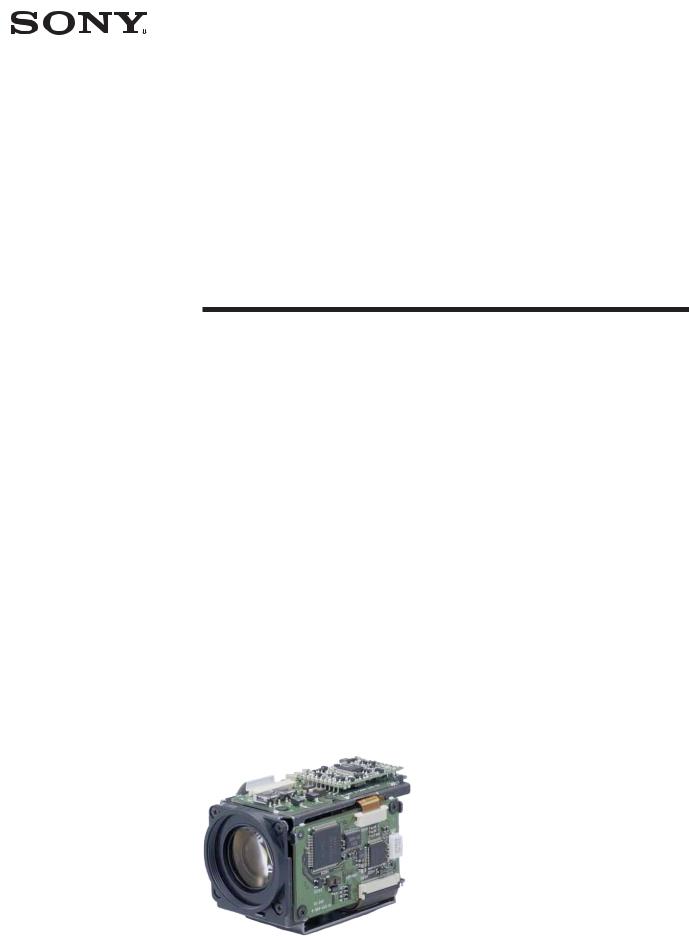
A-C4E-100-11 (1)
Color Camera Module
Technical Manual
FCB-IX11A/IX11AP
2004 Sony Corporation
Table of Contents
Features ..................................................................... |
3 |
Locations of Controls ............................................... |
4 |
Basic Functions ......................................................... |
5 |
Overview of Functions ................................................ |
5 |
Eclipse ...................................................................... |
11 |
Spectral Sensitivity Characteristics .......................... |
11 |
Vibration Specifications ............................................ |
11 |
Key Switch Circuitry ................................................. |
12 |
Key Function Specifications ..................................... |
13 |
Initial Settings, Custom Preset and Backup ............. |
15 |
Mode Condition ........................................................ |
17 |
Command List ......................................................... |
20 |
VISCA/RS-232C Commands ................................... |
20 |
FCB Series Camera Commands .............................. |
26 |
Specifications .......................................................... |
42 |
Precautions .............................................................. |
45 |
2

Overview
Features
•10× optical zoom.
•Adopts a newly developed DSP for improved picture quality when using the digital zoom or the slow shutter.
•VISCA is a communications protocol, which enables the camera to be controlled remotely by commands from a host computer/controller.
•Six memory locations are provided to temporarily save and recall up to six sets of camera settings.
•The EX-view HAD CCD features 380,000 effective picture elements and shooting with enhanced sensitivity. The minimum illumination required is 1.5 lux (1/60 s (NTSC), 1/50 s (PAL)).
With consideration given to environmental protection, this module is designed to operate with low power consumption and incorporates lead-free and halogenfree circuit boards.
3
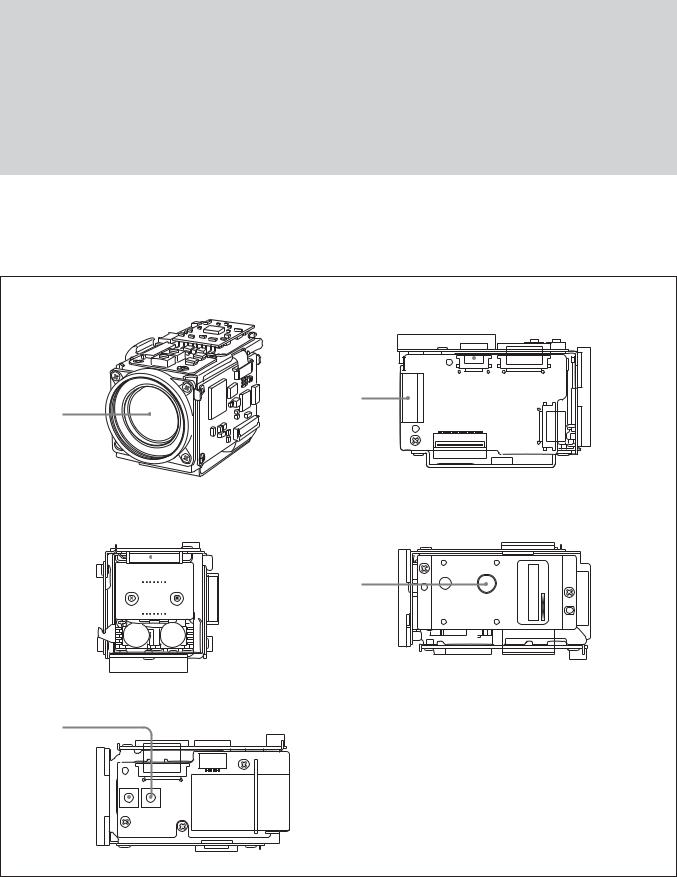
Locations of Controls
Locations of Controls
Main Unit
Front |
Top |
5
6
1
Rear
2
Bottom
7
Left side
3
4
1 Lens |
5 CN701 connector |
2 CN901 connector |
6 CN751 connector |
3 WIDE button |
7 Tripod screw holes |
4 TELE button |
When a tripod is used, please use 5.5 mm (7/32 in.) |
|
screws to attach it to the camera. Also, please be sure |
|
to attach the tripod securely. |
4
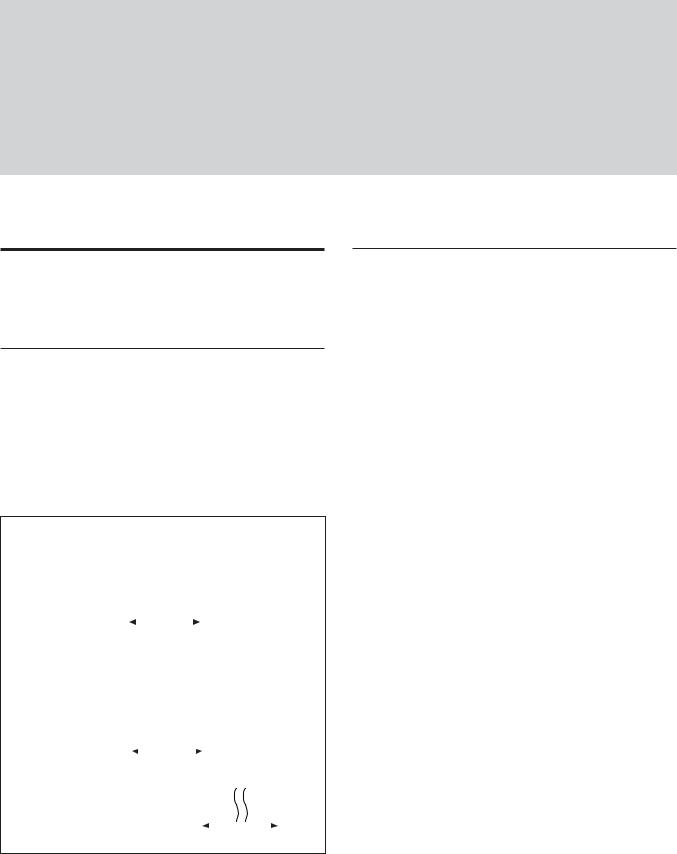
Basic Functions
Basic Functions
Overview of Functions
VISCA commands form the basis of camera control.
Timing Chart
As VISCA Command processing can only be carried out once in a Vertical cycle, it takes the maximum 1V cycle time for an ACK/Completion to be returned.
If the Command ACK/Completion communication time can be cut shorter than the1V cycle time, then every 1V cycle can receive a Command.
General Commands
|
Command |
|
|
|
|
|
|
|
|
|
|
|
|||||
RxD |
|
|
|
|
|
|
|
|
|
|
ACK Completion |
||||||
|
|
|
|
|
|
|
|
|
|
||||||||
|
|
|
|
|
|
|
|
|
|
||||||||
|
|
|
|
|
|
|
|
|
|
|
|||||||
TxD |
|
|
|
|
|
|
|
|
|
|
|
|
|
|
|
|
|
|
|
|
|
|
|
|
|
|
|
|
|
|
|
|
|
|
|
|
|
Within 16.7msec (20msec*PAL) |
|||||||||||||||
Query Commands
|
|
Within 16.7msec (20msec*PAL) |
|||||||||||||||||
RxD |
Command |
|
|
|
|
|
|
Completion |
|||||||||||
|
|
|
|
|
|
||||||||||||||
|
|
|
|
|
|
|
|
|
|
|
|
||||||||
|
|
|
|
|
|
|
|
|
|
|
|
||||||||
TxD |
|
|
|
|
|
|
|
|
|
|
|
|
|
|
|
|
|
|
|
|
|
|
|
|
|
|
|
|
|
|
|
|
|
|
|
|
|
|
|
|
|
|
|
|
|
|
|
|
|
|
|
|
|
|
|||||
|
|
|
|
|
|
|
|
|
|
|
|
16 Byte |
|||||||
General
•Power On/Off
Powers the camera on and off. When the power is off, the camera is able to accept only the lowest level of VISCA Commands; the display and other features are turned off.
•I/F clear
Clears the Command buffer of the FCB series camera. Clearing the buffer can also be carried out from the control application software when the power is on.
•Address set
VISCA is a protocol, which normally can support a daisy chain of up to seven attached devices. Whenever a camera is connected for the first time, be sure to use the address set to confirm the address.
•ID Write
Sets the camera ID.
•Mute
Blanks the screen and sends out a synchronizing signal.
•Lens Initialization
Initializes the zoom and focus of the lens. Even when power is already on, it initializes the zoom and the focus.
•Comp Scan
A pixel blemish-masking feature is used to reevaluate overall CCD pixel blemishes and mask severely flawed pixels automatically upon receiving the COMP SCAN command. This feature helps to mask the flaws found in CCD imagers, even after the camera has been powered on for some time.
5

Zoom
The FCB series camera employs an 10× optical zoom lens combined with a digital zoom function allowing you to zoom up to 40×.
Lens specifications: Optical 10×, f = 4.2 to 42 mm (F1.8 to F2.9)
The horizontal angle of view is approximately 46 degrees (wide end) to 4.6 degrees (tele end). Digital Zoom enlarges the center of the subject by expanding each image in both the vertical and horizontal directions. When 40× zoom is used, the
number of effective picture elements in each direction reduces to 1/4 and the overall resolution deteriorates.
You can activate the zoom in the following two ways:
•By pressing the TELE or WIDE button on the camera itself.
•Using a VISCA Command
Using Standard Mode
Using Variable Mode
There are eight levels of zoom speed.
Direct Mode
Setting the zoom position enables quick movement to the designated position.
Digital Zoom ON/OFF
In these standard and variable Speed Modes, it is necessary to send a “Stop Command” to stop the zoom operation.
•The Zoom Mode supports a Combined Mode and a Separate Mode.
Combined Mode
This is the previously existing zoom method. After the optical zoom has reached its maximum level, the camera switches to Digital Zoom Mode.
Separate Mode
In this mode, Optical Zoom and Digital Zoom can be operated separately. You can use digital zoom magnification at any time from within any level of optical magnification.
Focus
Focus has the following modes, all of which can be set using VISCA Commands.
•Auto Focus Mode
The minimum focus distance is 10 mm at the optical wide end and 1000 mm at the optical tele end, and is independent of the digital zoom.
Basic Functions
The AutoFocus (AF) function automatically adjusts the focus position to maximize the high frequency content of the picture in a center measurement area, taking into consideration the high luminance and strong contrast components.
- Normal AF Mode
This is the normal mode for AF operations.
- Interval AF Mode
The mode used for AF movements carried out at defined intervals. The time intervals for AF movements and for the timing of the stops can be set in one-second increments using the Set Time Command. The initial value for both is set to five seconds.
- Zoom Trigger Mode
When the zoom is changed with the TELE button, WIDE button, VISCA Zoom commands or key switches, the pre-set value (initially set at 5 seconds) becomes that for AF Mode. Then, it returns to Manual Focus mode.
AF sensitivity can be set to either HIGH or LOW.
- HIGH
Reaches the highest focus speed quickly. Use this when shooting a subject that moves frequently. Usually, this is the most appropriate mode.
- LOW
Improves the stability of the focus. When the lighting level is low, the AF function does not take effect, even though the brightness varies, contributing to a stable image.
When used for 24 hours continuously, initialization of lens system once a day is recommended because this will make the life of lens longer. The Initialize Lens Command takes a little less than 3 seconds to initialize the focus and zoom.
•Manual Focus Mode
Manual Focus has both a Standard Speed Mode and a Variable Speed Mode. Standard Speed Mode focuses at a fixed rate of speed. Variable Speed Mode has eight speed levels that can be set using a VISCA Command.
•One Push Trigger Mode
When a Trigger Command is received, the lens moves to adjust the focus for the subject. The focus lens then holds the same position until the next Trigger Command is input.
•Infinity Mode
The lens is forcibly moved to a position suitable for an unlimited distance.
•Near Limit Mode
Can be set in a range from 1000 (∞) to C000 (10 mm).
6

White Balance
White Balance has the following modes, all of which can be set using VISCA Commands.
•Auto White Balance
This mode computes the white balance value output using color information from the entire screen. It outputs the proper value using the color temperature radiating from a black subject based on a range of values from 3000 to 7500K.
This mode is the default setting.
•ATW
Auto Tracing White balance (2000 to 10000 K)
•Indoor
3200 K Base Mode
•Outdoor
5800 K Base Mode
•One Push WB
The One Push White Balance mode is a fixed white balance mode that may be automatically readjusted only at the request of the user (One Push Trigger), assuming that a white subject, in correct lighting condition, and occupying more than 1/2 of the image, is submitted to the camera.
One Push White Balance data is lost when the power is turned off. If the power is turned off, reset the One Push White Balance.
•Manual WB
Manual control of R and B gain, 256 steps each
Automatic Exposure Mode
The variety of AE functions, which allow video signal to output the optimum image for subjects from low light conditions to bright light conditions, are available.
•Full Auto
Auto Iris and Gain, Fixed Shutter Speed (NTSC: 1/60 s, PAL: 1/50 s)
•Shutter Priority 1)
Variable Shutter Speed, Auto Iris and Gain
(1/1 to 1/10,000 s, 22 steps, std. shutter: 16 steps, slow shutter: 6 steps)
•Iris Priority
Variable Iris (F1.8 to Close, 18 steps), Auto Gain and Shutter speed
•Manual
Variable Shutter, Iris and Gain
•Bright
Variable Iris and Gain (Close to F1.8, 17 steps at 0 dB: F1.8, 15 steps from 0 to 28 dB)
Basic Functions
AE – Shutter Priority
The shutter speed can be set freely by the user to a total of 22 steps – 16 high speeds and 6 low speeds. When the slow shutter is set, the speed can be 1/30, 1/15, 1/8, or 1/4 s. The picture output is read at a normal
rate from the memory. The memory is updated at a low rate from the CCD. AF capability is low.
In high speed mode, the shutter speed can be set up to 1/10,000 s. The iris and gain are set automatically, according to the brightness of the subject.
Data |
NTSC |
PAL |
|
|
|
15 |
10000 |
10000 |
|
|
|
14 |
6000 |
6000 |
|
|
|
13 |
4000 |
3500 |
|
|
|
12 |
3000 |
2500 |
|
|
|
11 |
2000 |
1750 |
|
|
|
10 |
1500 |
1250 |
|
|
|
0F |
1000 |
1000 |
|
|
|
0E |
725 |
600 |
|
|
|
0D |
500 |
425 |
|
|
|
0C |
350 |
300 |
|
|
|
0B |
250 |
215 |
|
|
|
0A |
180 |
150 |
|
|
|
09 |
125 |
120 |
|
|
|
08 |
100 |
100 |
|
|
|
07 |
90 |
75 |
|
|
|
06 |
60 |
50 |
|
|
|
05 |
30 |
25 |
|
|
|
04 |
15 |
12 |
|
|
|
03 |
8 |
6 |
|
|
|
02 |
4 |
3 |
|
|
|
01* |
2 |
2 |
|
|
|
00* |
1 |
1 |
* For AE-Manual only.
AE – Iris Priority
The iris can be set freely by the user to 18 steps between F1.8 and Close.
The gain and shutter speed are set automatically according to the brightness of the subject.
Data |
Setting value |
Data |
Setting value |
|
|
|
|
11 |
F1.8 |
08 |
F8 |
|
|
|
|
10 |
F2.0 |
07 |
F9.6 |
|
|
|
|
0F |
F2.4 |
06 |
F11 |
|
|
|
|
0E |
F2.8 |
05 |
F14 |
|
|
|
|
0D |
F3.4 |
04 |
F16 |
|
|
|
|
0C |
F4.0 |
03 |
F19 |
|
|
|
|
0B |
F4.8 |
02 |
F22 |
|
|
|
|
0A |
F5.6 |
01 |
F28 |
|
|
|
|
09 |
F6.8 |
00 |
CLOSE |
|
|
|
|
................................................................................................................................................................................................................................. |
|
1) Flicker can be eliminated by setting shutter to: |
t 1/120 s for PAL models used in countries with a 60 Hz power supply |
t 1/100 s for NTSC models used in countries with a 50 Hz power |
frequency. |
supply frequency. |
7 |
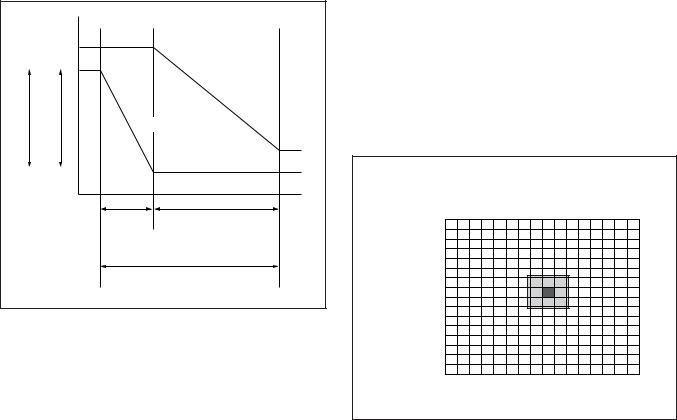
AE – Manual
The shutter speed (22 steps), iris (18 steps) and gain (16 steps) can be set freely by the user.
AE – Bright
The bright control function adjusts both the gain and iris using an internal algorithm according to a brightness level freely set by the user. Exposure is controlled by gain when dark, and by iris when bright. As both gain and iris are fixed, this mode is used when exposing at a fixed camera sensitivity. When switching from Full Auto or Shutter Priority Mode to Bright Mode, the current status will be retained for a short period of time.
Only when the AE mode is set to “Full Auto” or “Shutter Priority,” the user can switch it to “Bright.”
Gain |
|
IRIS AGC |
|
OPEN MAX |
|
|
IRIS curve |
|
Gain curve |
CLOSE MIN |
|
Dark |
Bright |
Controlled |
Controlled by IRIS |
by gain |
|
Bright limit which controllable for this unit
Data |
Iris |
Gain |
Data |
Iris |
Gain |
1F |
F1.8 |
28 dB |
0F |
F2.4 |
0 dB |
|
|
|
|
|
|
1E |
F1.8 |
26 dB |
0E |
F2.8 |
0 dB |
|
|
|
|
|
|
1D |
F1.8 |
24 dB |
0D |
F3.4 |
0 dB |
|
|
|
|
|
|
1C |
F1.8 |
22 dB |
0C |
F4.0 |
0 dB |
|
|
|
|
|
|
1B |
F1.8 |
20 dB |
0B |
F4.8 |
0 dB |
|
|
|
|
|
|
1A |
F1.8 |
18 dB |
0A |
F5.6 |
0 dB |
|
|
|
|
|
|
19 |
F1.8 |
16 dB |
09 |
F6.8 |
0 dB |
|
|
|
|
|
|
18 |
F1.8 |
14 dB |
08 |
F8.0 |
0 dB |
|
|
|
|
|
|
17 |
F1.8 |
12 dB |
07 |
F9.6 |
0 dB |
|
|
|
|
|
|
16 |
F1.8 |
10 dB |
06 |
F11 |
0 dB |
|
|
|
|
|
|
15 |
F1.8 |
8 dB |
05 |
F14 |
0 dB |
|
|
|
|
|
|
14 |
F1.8 |
6 dB |
04 |
F16 |
0 dB |
|
|
|
|
|
|
13 |
F1.8 |
4 dB |
03 |
F19 |
0 dB |
|
|
|
|
|
|
12 |
F1.8 |
2 dB |
02 |
F22 |
0 dB |
|
|
|
|
|
|
11 |
F1.8 |
0 dB |
01 |
F28 |
0 dB |
|
|
|
|
|
|
10 |
F2.0 |
0 dB |
00 |
CLOSE |
0 dB |
|
|
|
|
|
|
Basic Functions
When switching from the Shutter Priority mode to the Bright mode, the shutter speed set in the Shutter Priority mode is maintained.
Spot Exposure Mode
In Full Auto AE, the level for the entire screen is computed and the optimum Auto Iris and Gain levels are determined. In Spot AE, a particular section of the subject can be designated, and then that portion of the image can be weighted and a value computed so that Iris and Gain can be optimized to obtain an image. For example, in an image with a lot of movement and with varying levels of brightness, portions without much change can be designated as such a “spot,” and changes to the screen can be minimized in that area. As shown in the diagram below, a range of 16 blocks vertically and 16 blocks horizontally can be designated.
In the case where the center is designated (shown in black), the level is computed along with a weighted value for the surrounding block (shaded), including the specified portions; and then the Gain and Iris are set. The value of the designated portions and the surrounding areas should be calculated as 90% and the rest should be set to 10%.
Horizontal 16
0 1 2 3 4 5 6 7 8 9 A B C D E F
0
1
2
Vertical 16 34
5
6
7
8
9 A B C D E F
8

Exposure Compensation
Exposure compensation is a function which offsets the internal reference brightness level used in the AE mode by steps of 1.5 dB.
Data |
Step |
Setting value |
|
|
|
0E |
7 |
10.5 dB |
|
|
|
0D |
6 |
9 dB |
|
|
|
0C |
5 |
7.5 dB |
|
|
|
0B |
4 |
6 dB |
|
|
|
0A |
3 |
4.5 dB |
|
|
|
09 |
2 |
3 dB |
|
|
|
08 |
1 |
1.5 dB |
|
|
|
07 |
0 |
0 dB |
|
|
|
06 |
–1 |
–1.5 dB |
|
|
|
05 |
–2 |
–3 dB |
|
|
|
04 |
–3 |
–4.5 dB |
|
|
|
03 |
–4 |
–6 dB |
|
|
|
02 |
–5 |
–7.5 dB |
|
|
|
01 |
–6 |
–9 dB |
|
|
|
00 |
–7 |
–10.5 dB |
|
|
|
Aperture Control
Aperture control is a function which adjusts the enhancement of the edges of objects in the picture. There are 16 levels of adjustment, starting from “no enhancement.” When shooting text, this control may help by making the text sharper.
Back Light Compensation
When the background of the subject is too bright, or when the subject is too dark due to shooting in the AE mode, back light compensation will make the subject appear clearer.
Slow Shutter – Auto/Manual
When the Slow Shutter is set to “Auto,” this ensures that the slow shutter is engaged automatically when the brightness drops. This occurs only when the AE mode is set to “Full Auto.”
“Slow Shutter Manual” is the factory setting.
Basic Functions
Camera ID
The ID can be set up to 65,536 (0000 to FFFF). As this will be memorized in the nonvolatile memory inside the camera, data will be saved regardless of whether it has been backed up.
Effect
It consists of the following functions.
•Neg. Art: Negative/Positive Reversal
•Black White: Monochrome Image
Others
Mirror Image
The video output from the camera can be reversed left and right using this function.
Freeze
This function captures an image in the field memory of the camera so that this image can be output continuously.
Because communication inside the camera is based on V cycle, the captured image is always the one 3V to 4Vs after the sending of a Command. Thus, you can not specify a time period after sending EVEN, ODD or a Command.
9

Memory (Position Preset)
Using the position preset function, 6 sets of camera shooting conditions can be stored and recalled.
This function allows you to achieve the desired status instantly even without adjusting the following items each time:
•Zoom Position
•Digital Zoom On/Off
•Focus Auto/Manual
•Focus Position
•AE Mode
•Shutter control parameters
•Bright Control
•Iris control parameters
•Gain control parameters
•Exposure Compensation On/Off
•Exposure Level
•Backlight Compensation On/Off
•Slow Shutter Auto/Manual
•White Balance Mode
•R/B Gain
•Aperture
Custom Preset
As with the position preset function, the camera shooting conditions can be stored and recalled. The settings are recalled when the power is turned on. For setting items, refer to the “Initial Settings, Custom Preset and Backup” section on page 15.
Title Display
The camera can be given a title containing up to 20 characters such as “ENTRANCE” or “LOBBY”. The position of the first character (horizontal, vertical) of the title, blinking state, and color can also be changed.
|
|
|
|
|
Basic Functions |
|||
|
|
|
|
|
|
|
|
|
Vposition |
|
|
|
00 to 0A |
|
|
||
|
|
|
|
|
|
|
|
|
Hposition |
|
|
|
00 to 17 |
|
|
||
|
|
|
|
|
|
|
||
Blink |
|
|
|
00: Does not blink |
|
|||
|
|
|
|
|
|
|
|
|
|
|
|
|
01: Blinks |
|
|
||
|
|
|
|
|
|
|
||
|
|
|
|
|
|
|
|
|
|
|
|
|
00 |
|
|
White |
|
|
|
|
|
|
|
|
|
|
|
|
|
|
01 |
|
|
Yellow |
|
|
|
|
|
|
|
|
|
|
|
|
|
|
02 |
|
|
Violet |
|
|
|
|
|
|
|
|
|
|
Color |
|
|
|
03 |
|
|
Red |
|
|
|
|
|
|
|
|
|
|
|
|
|
|
04 |
|
|
Cyan |
|
|
|
|
|
|
|
|
|
|
|
|
|
|
05 |
|
|
Green |
|
|
|
|
|
|
|
|
|
|
|
|
|
|
06 |
|
|
Blue |
|
|
|
|
|
|
|
|
|
|
|
|
|
|
|
|
|
|
|
00 |
01 |
02 |
03 |
04 |
05 |
|
06 |
07 |
|
|
|
|
|
|
|
|
|
A |
B |
C |
D |
E |
F |
G |
H |
|
|
|
|
|
|
|
|
|
|
08 |
09 |
0a |
0b |
0c |
0d |
0e |
0f |
|
|
|
|
|
|
|
|
|
|
I |
J |
K |
L |
M |
N |
O |
P |
|
|
|
|
|
|
|
|
|
|
10 |
11 |
12 |
13 |
14 |
15 |
|
16 |
17 |
|
|
|
|
|
|
|
|
|
Q |
R |
S |
T |
U |
V |
W |
X |
|
|
|
|
|
|
|
|
|
|
18 |
19 |
1a |
1b |
1c |
1d |
1e |
1f |
|
|
|
|
|
|
|
|
|
|
Y |
Z |
& |
|
? |
! |
|
1 |
2 |
|
|
|
|
|
|
|
|
|
20 |
21 |
22 |
23 |
24 |
25 |
|
26 |
27 |
|
|
|
|
|
|
|
|
|
3 |
4 |
5 |
6 |
7 |
8 |
|
9 |
0 |
|
|
|
|
|
|
|
|
|
28 |
29 |
2a |
2b |
2c |
2d |
2e |
2f |
|
|
|
|
|
|
|
|
|
|
À |
È |
Ì |
Ò |
Ù |
Á |
|
É |
Í |
|
|
|
|
|
|
|
|
|
30 |
31 |
32 |
33 |
34 |
35 |
|
36 |
37 |
|
|
|
|
|
|
|
|
|
Ó |
Ú |
 |
Ê |
Ô |
Æ |
|
Π|
à |
|
|
|
|
|
|
|
|
|
38 |
39 |
3a |
3b |
3c |
3d |
3e |
3f |
|
|
|
|
|
|
|
|
|
|
Õ |
Ñ |
Ç |
ß |
Ä |
Ï |
|
Ö |
Ü |
|
|
|
|
|
|
|
|
|
40 |
41 |
42 |
43 |
44 |
45 |
|
46 |
47 |
|
|
|
|
|
|
|
|
|
Å |
$ |
F |
¥ |
DM |
£ |
|
¿ |
¡ |
|
|
|
|
|
|
|
|
|
48 |
49 |
4a |
4b |
4c |
4d |
4e |
4f |
|
|
|
|
|
|
|
|
|
|
ø |
“ |
: |
‘ |
. |
, |
|
/ |
- |
|
|
|
|
|
|
|
|
|
Date and Time Display
The date and time (accuracy: ±30 s/month) can be displayed on the video monitor using a Display command.
10
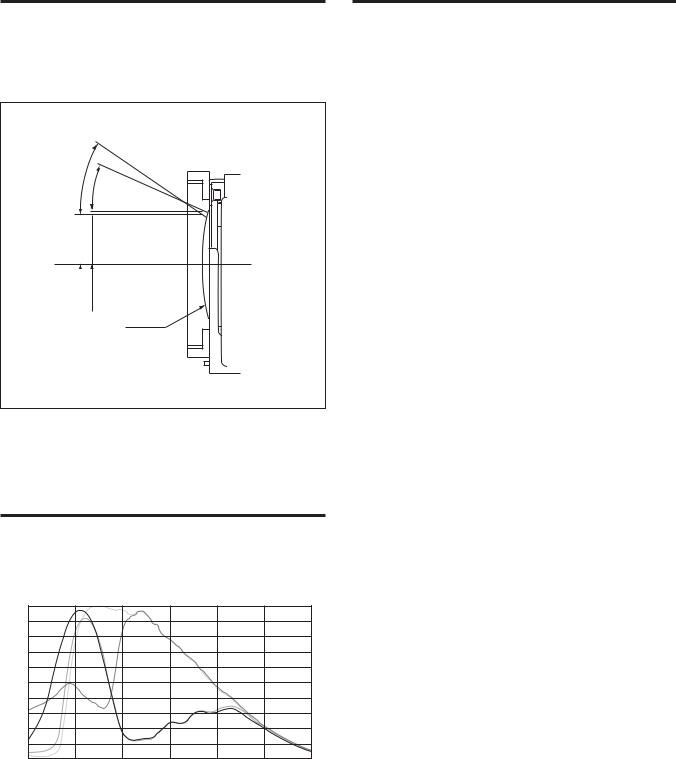
Eclipse
When designing the housing, refer to the dimensional allowance as shown in the figure below.
97˚ |
82˚ |
. |
|
30 . |
|
|
21 |
8.92 |
9.56 |
|
|
Basic Functions
Vibration
Specifications
Test Method (Random vibration)
•Fix the camera at the four fixation points of the base using M2 screws.
•Perform the random vibration test under the following conditions in the X, Y and Z directions for 20 minutes in each direction.
•The camera vibration specification is to have no malfunction after this test.
Power spectrum density |
5 to 50 Hz |
4.14 m2/s3 |
{0.043 G2/Hz} |
|
|
50 to 100 Hz |
–36 dB/oct |
|
|
|
|
|
||
Effective overall value |
14.3 m/s2 |
{1.46 G} |
||
|
|
|
|
|
Test time |
20 minutes |
|
|
|
|
|
|
|
|
Spectral Sensitivity
Characteristics
Relative Response
1 |
|
Ye |
|
|
|
|
0.9 |
|
|
|
|
|
|
|
|
|
|
|
|
|
Cy |
|
G |
|
|
|
|
0.8 |
|
|
|
|
|
|
0.7 |
|
|
|
|
|
|
0.6 |
|
|
|
|
|
|
0.5 |
|
|
|
|
|
|
0.4 |
|
|
|
|
|
|
0.3 |
|
Mg |
|
|
|
|
|
|
|
|
|
|
|
0.2 |
|
|
|
|
|
|
0.1 |
|
|
|
|
|
|
0 |
|
|
|
|
|
|
400 |
500 |
600 |
700 |
800 |
900 |
1000 |
Wave Length [nm]
11
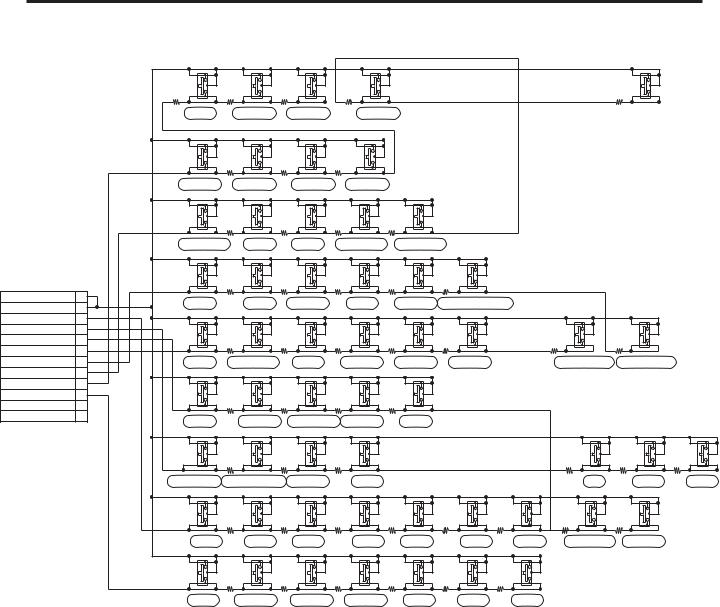
Basic Functions
Key Switch Circuitry
|
|
|
S101 |
S112 |
S121 |
S130 |
|
|
|
|
|
|
S152 |
|
||
|
|
|
R101 |
R105 |
R114 |
|
R123 |
|
|
|
|
R145 |
27k |
|
||
|
|
|
3900 |
8200 |
27k |
|
8200 |
|
|
|
|
|
||||
|
|
|
DZOOM |
DZOOM WIDE |
DZOOM TELE |
|
DZOOM MAX |
|
|
|
|
|
|
|
||
|
|
|
S102 |
S113 |
S122 |
|
S131 |
|
|
|
|
|
|
|
|
|
|
|
|
|
R106 |
R119 |
|
R128 |
|
|
|
|
|
|
|
|
|
|
|
|
|
1200 |
1500 |
|
2200 |
|
|
|
|
|
|
|
|
|
|
|
|
WIDE FAST |
WIDE SLOW |
|
TELE SLOW |
TELE FAST |
|
|
|
|
|
|
|
|
|
|
|
|
S103 |
S114 |
S123 |
|
S132 |
|
S139 |
|
|
|
|
|
|
|
|
|
|
|
R107 |
R115 |
|
R124 |
|
R131 |
|
|
|
|
|
|
|
|
|
|
|
1200 |
1500 |
|
2200 |
|
3900 |
|
|
|
|
|
|
|
|
|
|
AF ON/OFF |
NEAR |
|
FAR |
ONE PUSH AF |
|
INFINITY |
|
|
|
|
|
|
|
|
|
|
S104 |
S115 |
S124 |
|
S133 |
|
S140 |
|
S150 |
|
|
|
|
|
|
|
|
|
R108 |
R116 |
|
R125 |
|
R132 |
|
R142 |
|
|
|
|
|
12P |
CN101 |
|
1200 |
1500 |
|
2200 |
|
3900 |
|
8200 |
|
|
|
|
|
|
|
GND |
1 |
AE AUTO |
BRIGHT |
|
SHUTTER |
|
IRIS |
BACK LIGHT |
AUTO SLOW SHUTTER |
|
|
|
|
||
|
GND |
2 |
|
|
|
|
|
|
||||||||
|
|
|
|
|
|
|
|
|
|
|
|
|
|
|
||
KEY_AD0 |
3 |
S105 |
S116 |
S127 |
|
S134 |
|
S141 |
|
S145 |
|
S151 |
|
S154 |
|
|
KEY_AD1 |
4 |
|
|
|
|
|
|
|||||||||
|
|
|
|
|
|
|
|
|
|
|
|
|
|
|||
KEY_AD2 |
5 |
|
R109 |
R117 |
|
R126 |
|
R133 |
|
R137 |
|
R144 |
|
R147 |
|
|
KEY_AD3 |
6 |
|
1200 |
1500 |
|
2200 |
|
3900 |
|
8200 |
|
27k |
|
27k |
|
|
|
|
|
|
|
|
|
|
|
|
|
|
|
|
|||
KEY_AD4 |
7 |
AUTO WB |
ONE PUSH WB |
ATW |
|
INDOOR |
|
OUTDOOR |
MANUAL WB |
|
APERTURE UP |
|
APERTURE DOWN |
|||
KEY_AD5 |
8 |
|
|
|
|
|
|
|
|
|
|
|
|
|
|
|
KEY_AD6 |
9 |
S106 |
S117 |
S125 |
|
S135 |
|
S142 |
|
|
|
|
|
|
|
|
KEY_AD7 |
10 |
|
|
|
|
|
|
|
|
|
|
|
|
|
||
|
R104 |
R113 |
|
R122 |
|
R134 |
|
|
|
|
|
|
|
|||
|
|
|
|
|
|
|
|
|
|
|
|
|
||||
|
NC |
11 |
|
1200 |
1500 |
|
2200 |
|
3900 |
|
|
|
|
|
|
|
STROBE |
12 |
FREEZE |
LR-REVERSE |
BLACK&WHITE |
NEGA ART |
|
MUTE |
|
|
|
|
|
|
|||
|
|
|
|
|
|
|
|
|
|
|||||||
|
|
|
S107 |
S118 |
S126 |
|
S136 |
|
|
|
|
|
S153 |
|
S155 |
S156 |
|
|
|
|
R110 |
R118 |
|
R127 |
|
|
|
|
|
R143 |
|
R146 |
R148 |
|
|
|
|
1200 |
1500 |
|
2200 |
|
|
|
|
|
3900 |
|
8200 |
27k |
|
|
|
TIME/DATE SET |
TIME/DATE DISPLAY |
DISPLAY |
|
TITLE |
|
|
|
|
UP |
|
DOWN |
EXEC |
|
|
|
|
S108 |
S110 |
S119 |
|
S128 |
S137 |
|
S143 |
S146 |
S148 |
|
S149 |
|
|
|
|
|
|
R102 |
R111 |
|
R120 |
|
R130 |
|
R136 |
R139 |
R140 |
R141 |
|
|
|
|
|
|
1200 |
1500 |
|
2200 |
|
3900 |
|
8200 |
27k |
8200 |
|
27k |
|
|
|
|
POS0 |
POS1 |
|
POS2 |
|
POS3 |
|
POS4 |
POS5 |
CUSTOM |
POS PRESET |
|
POS RESET |
|
|
|
|
S109 |
S111 |
S120 |
|
S129 |
S138 |
|
S144 |
S147 |
|
|
|
|
|
|
|
|
|
R103 |
R112 |
|
R121 |
|
R129 |
|
R135 |
R138 |
|
|
|
|
|
|
|
|
1200 |
1500 |
|
2200 |
|
3900 |
|
8200 |
27k |
|
|
|
|
|
|
|
AF SENS |
ICR ON OFF |
|
BRIGHT UP |
|
BRIGHT DOWN |
FREE KEY |
FREE KEY |
FREE KEY |
|
|
|
|
|
12
|
|
|
|
Basic Functions |
|
|
|
|
|
Key Function Specifications |
|
|
||
|
|
|
|
|
Classification |
Name |
Function |
Button operation |
Mode display |
|
|
|
|
|
ZOOM |
WIDE |
Move ZOOM to WIDE side quickly. |
Pressing repeatedly allowed. |
ZOOM bar displayed |
|
|
|
|
for 3 s. |
|
|
|
|
|
|
WIDE SLOW |
Move ZOOM to WIDE side slowly. |
Pressing repeatedly allowed. |
ZOOM bar displayed |
|
|
|
|
for 3 s. |
|
|
|
|
|
|
TELE SLOW |
Move ZOOM to TELE side slowly. |
Pressing repeatedly allowed. |
ZOOM bar displayed |
|
|
|
|
for 3 s. |
|
|
|
|
|
|
TELE FAST |
Move ZOOM to TELE side quickly. |
Pressing repeatedly allowed. |
ZOOM bar displayed |
|
|
|
|
for 3 s. |
|
|
|
|
|
D-ZOOM |
DZOOM |
Turn on/off the mode for shifting from optical |
Switch on/off. |
ZOOM bar displayed |
|
|
MAX to electronic ZOOM in combined mode. |
|
for 3 s. |
|
|
|
|
|
|
DZOOM |
Move the electronic ZOOM to WIDE side in |
Pressing repeatedly allowed. |
ZOOM bar displayed |
|
WIDE |
separate mode. |
|
for 3 s. |
|
|
|
|
|
|
DZOOM |
Move the electronic ZOOM to TELE side in |
Pressing repeatedly allowed. |
ZOOM bar displayed |
|
TELE |
separate mode. |
|
for 3 s. |
|
|
|
|
|
|
DZOOM |
Switch the electronic ZOOM between 1× and |
Switch between 1× and MAX |
ZOOM bar displayed |
|
MAX |
MAX in separate mode. |
magnification. |
for 3 s. |
|
|
|
|
|
FOCUS |
AF |
Switch between Auto Focus and Manual Focus. |
Switch between Auto and |
Manual F indication |
|
|
|
Manual. |
|
|
|
|
|
|
|
NEAR |
Move focus to NEAR side in Manual Focus |
Pressing repeatedly allowed. |
Near indication |
|
|
mode. |
|
|
|
|
|
|
|
|
FAR |
Move focus to FAR side in Manual Focus mode. |
Pressing repeatedly allowed. |
Far indication |
|
|
|
|
|
|
ONE PUSH |
Perform AF operation once in Manual Focus |
Request One Push AF. |
Manual F indication |
|
AF |
mode. |
|
flashes while request |
|
|
|
|
is made. |
|
|
|
|
|
|
INFINITY |
Move focus forcibly to Infinity resulting in |
Request Infinity. |
Far indication |
|
|
Manual Focus mode, regardless of the current |
|
|
|
|
focus mode. |
|
|
|
|
|
|
|
AE |
AE AUTO |
Switch to AE FULL Auto mode. |
Request AE Full Auto. |
No display |
|
|
|
|
|
|
BRIGHT |
Switch to variable brightness mode (BRIGHT), |
Request Bright mode. |
Bright bar display |
|
|
depending on the conditions for mode shifting. |
Pressing Up/Down key |
|
|
|
|
repeatedly allowed. |
|
|
|
|
|
|
|
SHUTTER |
Shutter priority AE mode |
Request shutter priority AE |
Shutter code display |
|
|
|
mode. |
|
|
|
|
|
|
|
IRIS |
Iris priority AE mode |
Request iris priority AE |
Iris code display |
|
|
|
mode. |
|
|
|
|
|
|
|
BACK |
Switch backlight on/off. |
Switch on/off. |
Backlight indication |
|
LIGHT |
|
|
|
|
|
|
|
|
WB |
AUTO WB |
Switch to AUTO WB mode. |
Request Auto WB mode. |
No display |
|
|
|
|
|
|
ONE PUSH |
Switch to One Push WB mode when pressed |
Request One Push WB mode |
One Push indication |
|
WB |
once and capture data when pressed 2nd time. |
and trigger. |
flashes at 0.8 Hz |
|
|
|
|
before capturing data, |
|
|
|
|
at 3.2 Hz during |
|
|
|
|
capturing, and stays |
|
|
|
|
lit after capturing. |
|
|
|
|
|
|
ATW |
Switch to ATW mode. |
Request AWB mode. |
ATW display |
|
|
|
|
|
|
INDOOR |
Enable WB at 3200K in INDOOR mode. |
Request Indoor mode. |
Indoor indication |
|
|
|
|
|
|
OUTDOOR |
Enable WB at 5800K in OUTDOOR mode. |
Request Outdoor mode. |
Outdoor indication |
|
|
|
|
|
|
MANUAL |
Switch to Manual WB mode. |
Switch between R control |
“WB-MAN” |
|
WB |
Enable R control when pressed once and enable |
and B control in manual WB |
(character display) |
|
|
B control when pressed 2nd time. Switchable |
mode./Pressing Up/Down |
|
|
|
with UP/DOWN key. |
key repeatedly allowed. |
|
|
|
|
|
|
13
|
|
|
|
Basic Functions |
|
|
|
|
|
Classification |
Name |
Function |
Button operation |
Mode display |
|
|
|
|
|
FEATURE |
FREEZE |
Capture still image. |
Switch on/off. |
FREEZE indication |
|
|
|
|
|
|
LR- |
Horizontal reversal |
Switch on/off. |
Horizontal reversal |
|
REVERSE |
|
|
indication |
|
|
|
|
|
|
BLACK & |
Black-and-white output |
Switch on/off. |
B&W display |
|
WHITE |
|
|
|
|
|
|
|
|
|
NEGA ART |
Negative art output |
Switch on/off. |
Neg Art display |
|
|
|
|
|
|
MUTE |
Mute video output |
Switch on/off. |
“MUTE” (character |
|
|
|
|
display) |
|
|
|
|
|
DISPLAY |
TIME/DATE |
Set date and time. |
Request setting. t Setting |
Setting screen display |
|
SET |
Start setting with Exec, make settings with Up/ |
is started with Exec. |
|
|
|
Down key, and confirm settings with Exec. |
Pressing Up/Down key |
|
|
|
|
repeatedly allowed. |
|
|
|
|
|
|
|
TIME/DATE |
Switch display mode between OFF t time |
Switch date display/time |
Date/time display |
|
DISPLAY |
display t date display t date and time display |
display/off selection. |
|
|
|
mode and time display t OFF mode. |
|
|
|
|
|
|
|
|
DISPLAY |
Display |
Switch on/off. |
|
|
|
|
|
|
|
TITLE |
Title setting |
Request setting. t Setting |
Title setting screen |
|
|
|
is started with Exec. |
display |
|
|
|
Pressing Up/Down key |
|
|
|
|
repeatedly allowed. |
|
|
|
|
|
|
|
EXEC |
Confirm title/clock settings. |
Select with Up/Down and |
Setting screen selection |
|
|
|
confirm with Exec. |
highlighted in yellow. |
|
|
|
|
|
UP/DOWN |
UP |
Data UP key (priority for AE mode, Bright, |
Request UP. |
Selection highlighted. |
|
|
manual WB, title, and clock) |
|
|
|
|
|
|
|
|
DOWN |
Data DOWN key (priority for AE mode, Bright, |
Request DOWN. |
Selection highlighted. |
|
|
manual WB, title, and clock) |
|
|
|
|
|
|
|
PRESET |
POS1 |
Recall preset position 1. |
Request recall. |
RECALL POS0 |
|
|
|
|
|
|
POS2 |
Recall preset position 2. |
Request recall. |
RECALL POS1 |
|
|
|
|
|
|
POS3 |
Recall preset position 3. |
Request recall. |
RECALL POS2 |
|
|
|
|
|
|
POS4 |
Recall preset position 4. |
Request recall. |
RECALL POS3 |
|
|
|
|
|
|
POS5 |
Recall preset position 5. |
Request recall. |
RECALL POS4 |
|
|
|
|
|
|
POS6 |
Recall preset position 6. |
Request recall. |
RECALL POS5 |
|
|
|
|
|
|
POS7 |
Recall custom preset. |
Request recall. |
RECALL |
|
|
|
|
|
|
POS PRESET |
Write data. |
Request setting. Enabled |
PRESET display |
|
|
Enabled when pressed together with POS button. |
when pressed together with |
|
|
|
|
POS key. |
|
|
|
|
|
|
|
POS RESET |
Delete data. |
Request deletion. Enabled |
RESET display |
|
|
Enabled when pressed together with POS button. |
when pressed together with |
|
|
|
|
POS key. |
|
|
|
|
|
|
Others |
APERTURE |
Increase aperture (Aperture UP) |
Request UP. |
Aperture bar displayed |
|
UP |
|
|
for 3 s. |
|
|
|
|
|
|
AUTO SLOW |
Switch Auto Slow Shutter on/off. |
Switch on/off. |
“ASS” (character |
|
SHUTTER |
|
|
display) |
|
|
|
|
|
|
APERTURE |
Decrease aperture (Aperture DOWN) |
Request DOWN. |
Aperture bar displayed |
|
DOWN |
|
|
for 3 s. |
|
|
|
|
|
|
AF |
Switch AF sensitivity between Normal and Low. |
Switch between Normal and |
“SENS L” (character |
|
SENSITIVITY |
|
Low. |
display) |
|
|
|
|
|
|
BRIGHT UP |
Raise brightness setting (Bright UP) |
Request UP./Pressing |
Bright bar display |
|
|
(When not in Bright mode, switching to Bright mode |
repeatedly allowed. |
|
|
|
is made automatically depending on the conditions.) |
|
|
|
|
|
|
|
|
BRIGHT |
Lower brightness setting (Bright DOWN) |
Request DOWN./Pressing |
Bright bar display |
|
DOWN |
(When not in Bright mode, switching to Bright mode |
repeatedly allowed. |
|
|
|
is made automatically depending on the conditions.) |
|
|
|
|
|
|
|
14
